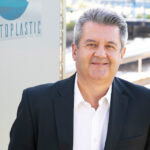Ismael Olmedo: "Our technology doesn’t just capture microplastics, but also offers a solutions for the protection of human health and the defense of the environment"
For Ismael Olmedo, CEO of Captoplastic, seeing clean, vibrant waterways is priceless —a value he cherishes more with age. He finds his company’s work particularly gratifying; they have developed technology to capture microplastics as small as one micron (0.001 mm), which are otherwise elusive and harmful to nature and health. We spoke with Olmedo to learn how this technology cancleanse ecosystems of these tiny pollutants and protect the environment.

Question: How are microplastics created? How do they affect us?
Answer: Microplastics are tiny plastic particles that come in various forms, including foams, beads, pellets, and fibers. They fall into two categories: primary microplastics, which are manufactured in small sizes like those in cosmetics, and secondary microplastics, which result from the breakdown of larger plastics through sun, wind, and water exposure. Most microplastics are released into the environment from sources such as washing machine wastewater and tire wear. For instance, washing synthetic clothing often releases fibers that enter wastewater and eventually flow into rivers and oceans. According to a WWF study, we ingest about five grams of plastic each week —the equivalent of a credit card. This can cause cardiac and carcinogenic problems, among other health issues.
Q: How do microplastics end up in our bodies?
A: Microplastics are often present in the food we eat, the water we drink or the air we breathe. Although the European legislation recognizes their danger and the need for measurement —such as in EU Directive 2020/2184 on drinking water quality and the recently published EU Directive 2024/3019 on urban wastewater treatment—, there is still no explicit obligation to capture them. Despite regulatory progress, regulations seem to be one step behind the problem, especially regarding the control and elimination of microplastics in wastewater.
Q: How do microplastics get into the water cycle?
A: Urban and industrial wastewater, which Captoplastic targets, is a major source of microplastic pollution that contaminates rivers and oceans. The concentration of microplastics varies widely, depending on factors such as the water’s industrial source or population density. In Spain, according to our estimates, untreated water contains between 30 and 100 milligrams of microplastics per liter.
"There is no single solution. It’s a matter of awareness and of gradually replacing plastic as a raw material for today’s multiple uses"
Q: Doesn’t a standard sewage treatment plant remove microplastics?
A: In the standard purification process, larger particles are removed first. This is followed by settling and biological treatments. Both primary and secondary treatments generate sludge, where microplastics often accumulate. The problem is that this sludge is used in agriculture or composting, potentially reintroducing microplastics into the environment.
Q: Captoplastic was founded in 2020 to address the microplastics problem. What inspired you to start the company, and what is your background?
A: It all began when researchers at Spain’s Universidad Autónoma de Madrid developed a patent for an innovative solution to capture and control microplastics, a global concern. This patent caught the eye of BeAble Capital, a Spanish fund specializing in Deep Tech (based on fundamental research), due to its environmental impact and potential as a disruptive technology against microplastic pollution. BeAble Capital recognized the patent’s commercial potential and provided funding and strategic support to turn it into a company. Thus, Captoplastic was born in 2020. We now hold ten patents for the identification, quantification, and removal of microplastics and employ about fifteen people. I am the CEO, but before this role, I spent 25 years as a director at Aguas de Barcelona and have a background in finance and management. Surrounding me are young engineers and chemists who possess extensive knowledge and a strong environmental awareness.

Q: What does your technology consist of and how does it contribute to solving the problem of microplastics?
A: We have two distinct product lines. First, we focus on the identification, quantification, and analysis of microplastics in water. Second, we work on their removal. To remove microplastics, we add a magnetic catcher to the water, which adheres to microplastics as small as one micron —while other solutions are limited to particles of five microns or larger. We then use a magnetic field to extract the aggregates. Finally, once the aggregate is out of the water, we separate the microplastics from the catcher, which we then reuse in the water to repeat the process continuously.
Q: Why is your technology innovative in this area?
A: Our technology stands out for its simplicity, sustainability, and efficiency compared to other market solutions. For instance, hydrocyclones, which separate solid particles in liquid media, require significant energy to generate the centrifugal force they need to operate effectively. In contrast, our technology consumes much less energy. Another alternative, membranes, require frequent replacement, an issue we don’t face since our catcher is reusable. This contributes to our lower operating costs compared to other solutions.
Q: Other technologies can also generate secondary waste, whereas our system captures microplastics before they reach the sludge without adding additional waste in the process.
A: And our technology doesn’t just capture microplastics, it allows them to be reused. A particular advantage of our system is its ability to recover microplastics without degrading them. The key to our uniqueness lies in the precision of our collection system and the ease with which we can separate the plastics without altering their structure. This capability opens the door to recycling and reuse initiatives in various industrial or design applications, such as creating panels or furniture from recycled plastics, thereby contributing to a circular model.
"Companies using our technology can reduce their environmental footprint and eliminate more than 80 percent of microplastics"
Q: How can businesses benefit from your technology?
A: Our technology benefits a wide range of enterprises, including urban and industrial water treatment plants, plastics manufacturers, the textile industry, water testing laboratories, and appliance manufacturers. It is also useful for the food and beverage industries that use large volumes of water. All of these sectors can eliminate more than 80% of microplastics and stay ahead of future regulations.
Q: How can we prevent microplastics from ending up in the water?
A: In this regard, we are developing a capture plant technology for industrial laundry and another that will incorporate a mechanism in the domestic washing machine that captures microplastics before they reach the wastewater treatment plants. Additionally, tires could be made from materials that degrade less and release fewer microplastics —an important consideration since many sewage systems combine wastewater and stormwater, causing all the water to end up in the treatment plant when it rains. Reducing the overall use of plastics would also be a significant measure to help lessen their environmental presence. There is no single solution. It’s a matter of awareness and of gradually replacing plastic as a raw material for today’s multiple uses.
